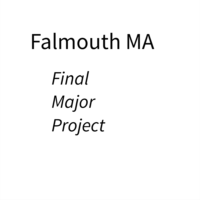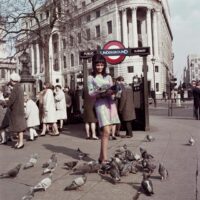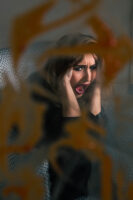During the preparation for the Face to Face event at Falmouth I suggested to Jesse that I could run a Location based Lighting workshop for students to get some hands on experience of using studio quality lighting on location. I have been using the Elinchrom Quadra and ELB battery powered packs for a number of years. I created the following abstract for inclusion in the schedule.
“This session is being run by FMP student Simon Fremont and will explore working with studio lighting on-location (Elinchrom battery powered flash units). The session will cover how different light modifiers shape the quality of light. There will be a chance to take test shoots during the workshop that will include single and multi-light setups.
What you’ll need:
- Any camera with a PC port or a hotshoe.
- Suitable clothing for working outdoors in February.”
The initial plan was to run a single session with 6 photographers and arrange for a model to be available and shoot on location close to the Photography Faculty. Based on popularity of the session I suggested to Jesse that I run a second session and focus on using lighting for capturing architecture which was added to the schedule.
My intention with both session was to provide the students with an overview and then provide them with the chance to get hands on with the equipment.
For the first session with a local model the weather provided an additional challenge requiring us to select a location where the equipment would not get wet. The Elinchrom packs have some weather sealing but they are not completely waterproof.
To start the session I walked the students through the equipment that I take on location with is transported in two large Elinchrom roller bags. One contains the power packs and heads. The second contains a basic set of light modifiers. Though the bigger modifiers and light stand are transported in their own travel bags. The cameras have their own roller bags that contains bodies and lenses. I explained that on location I work out of the cases replacing equipment back in the case when not in use. This ensures that equipment does not get lost on location and reduces teardown time at the end of the shoot. This level of equipment only works if I can drive close to the shoot location. Otherwise a team of support staff are required to help carry the equipment to site. The other thing that I view as very important when shooting on location is weights to help stabilise light stands as they can act like sails when using large modifiers even in gentle winds.
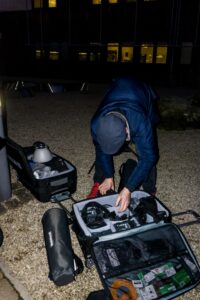
I provided students with a chance to get hands on with the equipment. Reviewing the back of the camera provided them with the ability to get immediate feedback on their work.
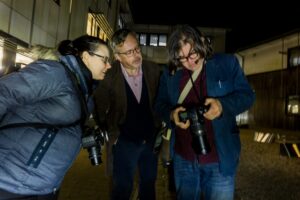
I provided a number of different light setups during the shoot encouraging the students to explore the relationship of subject, light source and camera and how this changes the quality of light within the frame.
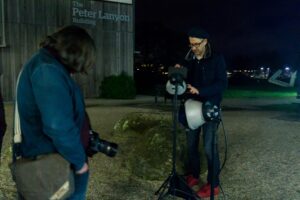
The feedback from the students was universally positive on the experience they gained during both workshops.
Conclusion
The workshop was useful learning experience for me. In the past I have run training course internally different employers over the years for groups of up to a dozen people so working with a small group of six was manageable. For a 1.5 hour workshop I felt I got the level of talking and practical time about right based on the feedback from the group. Though converting a 1.5 workshop into a day long workshop for a group of paying clients would be a different proposition.
I would like to spend additional time to prepare the material to cover during the workshop. In the first session I gave the group a too much freedom when selecting the lighting setup as they each wanted to decide on their lighting setup rather than agreeing as a group. I think I could have been clearer on the task during that element and made it easier to stay on schedule.
Having multiple triggers to share across the group made it easier to reducing the swap over time between photographers. Even with a group of MA students there was varying levels of experience. This is something that could be even more diverse with paying customers and something I would need to carefully consider when structuring the training material and to ensure each person got an appropriate level of development time.
At the end of the session I would liked to have allowed time the group to critique each others photographers as more me learning is most effective when it is undertaken as a shared experience.
In conclusion a good learning experience for all involved and something that I could develop further if I wanted to develop a training element to professional practice.

